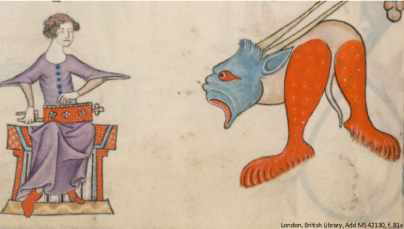8th session of the II Interdisciplinary Research Seminar: “Manuscritos em Diálogo”
25.01.2019 | 16:00 - 18:30
Building ID, Multipurpose Room 2, NOVA FCSH, Lisbon

1a Communication:
A música nos fundos e colecções da Torre do Tombo, by Maria de Fátima Ó Ramos (National Archive of Torre do Tombo)
A brief journey through a heritage that tells us about contexts, eras, composers and interpreters waiting for their due appreciation.
This presentation will be in Portuguese.
2a Communication:
Singing with light: revisiting the Ajuda Songbook by Graça Videira Lopes (IEM-NOVA FCSH), Maria João Melo (NOVA FCT; REQUIMTE) and Paula Nabais (NOVA FCT)
A heritage of medieval Galician-Portuguese song, the Chansonnier of Ajuda also contains a number of exceptional illuminations. A full characterisation of the materials used has been previously discussed in a special issue of the Journal of Medieval Iberian Studies, providing further information on the circumstances of its production. The materiality of this manuscript is intrinsically linked to its economic and cultural context, providing support to the argument presented by art historians and researchers of medieval literature that the Chansonnier dates to the late 13th or early 14th century. We also highlight the extraordinary state of preservation of the lapis lazuli and the presence of a rosewood colour – the first described use of this dye in medieval illumination. Considering the importance of these illuminations and the accompanying texts, in their Iberian context (especially in relation to the Cantigas de Santa Maria Songbook), we present a description of the previous study results before introducing the STEMMA project that will allow us to make comparisons with the contemporary Occitan and French songbooks and to discuss the production of this manuscript and other Galician-Portuguese songbooks between the 14th and 19th centuries.
This presentation will be in English.
About the Speakers:
Maria de Fátima Ó Ramos Senior technical manager, Division of Documentary and Archives Technical Processing (DTTDA). National Archive of Torre do Tombo.
Graça Videira Lopes is a professor (now retired) and a researcher at IEM-NOVA FCSH. Her main research field is Galician-Portuguese troubadour songs. She was the coordinator of the “Galician-Portuguese Medieval Songs” database and is now coordinating the new FCT STEMMA project on the study of medieval songbooks.
Maria João Melo is a Tenured Professor at the Department of Conservation and Restoration of the Faculty of Sciences and Technology, Nova University in Lisbon and a research scientist at REQUIMTE (Associated Laboratory for Sustainable Chemistry – Clean Processes and Technologies). Her current research subjects focus on the study of colour in Portuguese Medieval Illuminations and the study of the molecules of colour in Art and Nature.
Paula Nabais is a PhD student at the Department of Conservation and Restoration working on the identification of dyes with microspectrofluorimetry, based on the study of medieval manuscripts with different backgrounds. Recently, she has also started working on an FCT funded project, Polyphenols in Art, regarding the identification of the complexes of iron-gall inks and the selection of natural sources for yellow dyes in Portugal.
This event is part of the second series of seminars “Manuscritos em Diálogo” (Manuscripts in Dialogue). You can consult the full program of this cycle, here.
